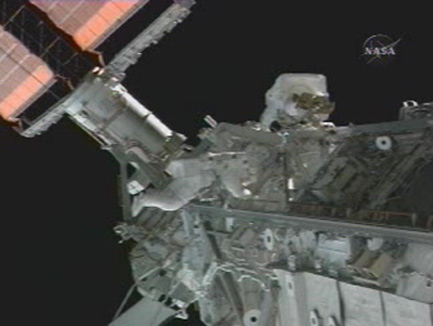Spacewalkers Prime New ISS Solar Arrays for Action

Thisstory was updated at 8:59 p.m. EDT
HOUSTON --Two astronauts primed the International Space Station?s (ISS) newest solarwings for full operations Sunday during an extra spacewalk by NASA?s Atlantisshuttle crew.
Atlantisshuttle astronauts Patrick Forrester and Steven Swanson spent more than sixhours outside the ISS on an excursion primarily aimed at unlocking a 10-foot(three-meter) wide rotary joint and freeing the station?s newstarboard solar arrays to track the Sun.
?That?svery good news,? Forrester said when the primary tasks were complete. ?It?swhat we came here to do.?
Sunday?sspacewalk began at 12:25 p.m. EDT (1625 GMT) from the station?s Quest airlock,marking the fourth extravehicular activity (EVA) for NASA?s STS-117 shuttlecrew. The shuttle astronauts delivered the station?s 17.5-ton Starboard3/Starboard 4 (S3/S4) truss segments and solar arrays to the ISS last week.
?It?s surepretty to see those arrays out there,? said NASA astronaut James Reilly, whochoreographed the spacewalkers? movements from inside Atlantis.
Sunday?sspacewalk and two extra docked days at the ISS were added to the STS-117mission to allow time for the repairof a torn protective blanket on the orbiter?s left aft engine pod during aprevious excursion.
Breaking space news, the latest updates on rocket launches, skywatching events and more!
A stubbornmicrometeoroid debris shield, which the spacewalkers had difficultyreinstalling after routing computer cable between U.S. and Russian ISS modules,marked the excursion?s only hitch. Forrester and Swanson secured the panel withtethers to keep it in place.
?It?sdefinitely not going to be flat enough to go down,? Forrester said.
A similarglitch occurred during a Friday spacewalk, when Reilly lashed a similarlyrecalcitrant shield into place. Forrester added more tethers to that seconddebris shield as well during Sunday?s spacewalk.
Solarwings set to turn
Forresterand Swanson spent most of their six-hour, 29-minute spacewalk at the end ofstation?s new S3 truss, where a pair of vital gears for a rotary joint werefound to be cross-wired duringa previous spacewalk.
Known asDrive Lock Assemblies, the gears drive the S3 truss? Solar Alpha Rotary Joint(SARJ), which is designed to turn the station?s new Starboard 4 (S4) truss andlater outboard segments like a Ferris wheel so their solar arrays always facethe Sun.
Forrester installedone of the two gears during a June 13 spacewalk, when the wiring mismatch wasdiscovered. He completed installation of its counterpart Sunday, then helpedSwanson remove restraints that had locked the SARJ joint in place.
The SARJjoint may make a five-degree test turn later tonight, ISS flight director HollyRidings said early Sunday. But it is not slated to begin fully tracking the Sununtil Monday, after Russian engineers determine that the station?s maincomputers governing its Russian-built attitude control system are again fully operationalafter recent glitches, she added.
Forresterand Swanson also installed a new video camera stanchion on the new S3 truss andcleared structures along its face that originally supported the hefty S3/S4segments inside Atlantis? payload bay. Their removal clears the path for thestation?s railcar-like Mobile Transporter to roll across the S3 truss to aworkstation at its starboard-most edge.
Other tasksincluded: removing bolts from station debris shields; opening a U.S. oxygengenerating system vent and securing its debris shield; running an Ethernetcable between Russian and U.S. modules; as well as positioning some tools for useon future spacewalks.
Spacewalktally
Sunday?sspacewalk marked the fourth for Forrester, who now has a total of 25 hours and30 minutes of EVA time, and the second for Swanson, giving him a tally of 13hours and 45 minutes, NASA officials said.
Altogether,the STS-117 spacewalking teams of Forrester and Swanson, as well as Reilly andNASA astronaut Danny Olivas, spent about 27 hours and 58 minutes workingoutside the ISS, they added.
?They didoutstanding,? said Keith Johnson, NASA?s lead STS-117 spacewalk officer, of thefour-astronaut team. ?It was just fun to watch.?
In additionto adding the new starboard solar arrays and trusses, the STS-117 astronautsalso helped furl a nearlyseven-year-old solar wing extending from the top of the station?s mast-likePort 6 (P6) truss to prepare the segment for later relocation.
Olivas alsorepaired the damaged thermal blanket on Atlantis? left Orbital ManeuveringSystem (OMS) pod using surgical staplers from medical kits aboard the shuttleand the ISS.
Sunday?sexcursion marked the 87th spacewalk devoted to the assembly ormaintenance of the ISS and the 59th to begin from the orbitallaboratory itself.
Despite thebusy day in orbit, astronauts aboard Atlantis and the ISS did not forget it wasFather?s Day, and took time to wish their families well.
BothForrester and Swanson wished their fathers and paternal relatives a happyFather's Day before reentering the space station?s Quest airlock.
?Absolutely,a lot of fathers on this flight and we?re all enjoying a great Father?s Day,?added Reilly, whose own children chose the theme to the television show ?Bandof Brothers? to awake the Atlantis crew Sunday.
Inside theISS, Expedition 15 astronaut Clay Anderson called Mission Control to say helloto his daughter Sutton Marie and son Cole, and reminded flight controllers tospend time with their own children after today?s busy day in space.
?HappyFather?s Day to everyone downstairs,? he said.
NASA isbroadcasting the space shuttle Atlantis' STS-117 mission live on NASA TV. Click here for mission updates andSPACE.com'svideo feed.
- SPACE.com Video Interplayer: Space Station Power Up with STS-117
- IMAGES: Atlantis Shuttle?s STS-117 Launch Day
- Complete Shuttle Mission Coverage

Tariq is the award-winning Editor-in-Chief of Space.com and joined the team in 2001. He covers human spaceflight, as well as skywatching and entertainment. He became Space.com's Editor-in-Chief in 2019. Before joining Space.com, Tariq was a staff reporter for The Los Angeles Times covering education and city beats in La Habra, Fullerton and Huntington Beach. He's a recipient of the 2022 Harry Kolcum Award for excellence in space reporting and the 2025 Space Pioneer Award from the National Space Society. He is an Eagle Scout and Space Camp alum with journalism degrees from the USC and NYU. You can find Tariq at Space.com and as the co-host to the This Week In Space podcast on the TWiT network. To see his latest project, you can follow Tariq on Twitter @tariqjmalik.
